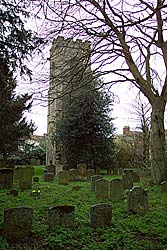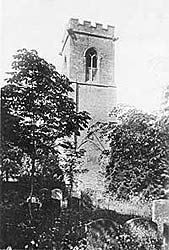|
|
||||
| 11. St Mary Magdalen Church | ||||
|
||||
|
At the lower end of the town near the river stands a solitary Church tower surrounded by an old graveyard.
Stony Stratford was unique in Buckinghamshire in having two parish churches: St Mary's and St Giles'. St Mary's was severely damaged in the great fire which swept through the lower part of the town in 1742. The fire originated in the Bull Hotel, having been started by a maid who had scorched some sheets - she heard her mistress approaching and quickly pushed the sheets up the chimney and out of view. The sheet caught alight and the ensuing fire went on to destroy much of the east side of Stony Stratford (and some of the west) including 146 houses, several famous inns and the Mary Magdalen Church of which only the tower now still stands. The blazing thatch of this fire fell as far away as Old Stratford. Total damage was estimated at £22,000. Following the 1742 fire, a rich eccentric antiquarian living in Bletchley called Browne Willis became interested in helping to restore the Church and tower. He paid for the re-leading of the roof, securing the building from decay and pointing the tower. He also donated money to relieve the distress of those who suffered. The six bells which fell during the fire lay in the churchyard for some time, until they were thought to have been sold or donated to a Church in St. Neots. Nowadays all gravestone inscriptions have to be submitted to the Urban Council for approval - but before that time, was produced an odd gravestone in the graveyard which read:- "Here lies a body who did no good, And if it had lived, it never would; Where it has gone, and how it fares, Nobody knows and nobody cares." St. Mary's Church and the English Civil War During the English Civil War in the 1640's, St.Marys Church on the Eastside (Wolverton) was the non-conformist church, and was Cromwellian (Roundhead). St. Giles Church on the Westside (Calverton) was the established church, and was Parliamentarian (Cavalier). Due to having two churches, a great divide occurred between the two churches, and the two parishes, and rivalry and suspicion was evident. In 1689 religious persecutions had ceased with the introduction of the Toleration Act. |
||||
|
|
||||
|
||||

